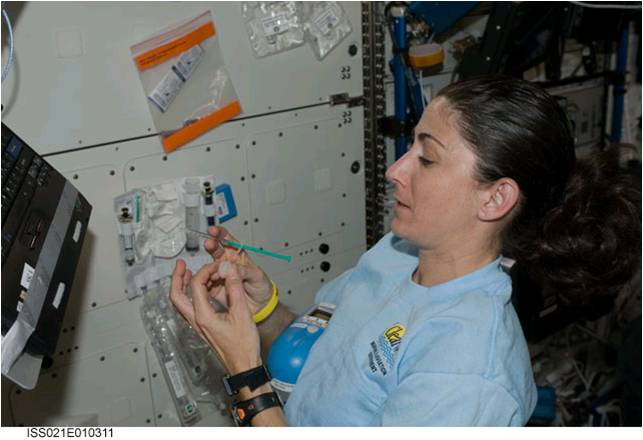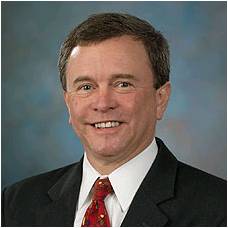In today’s A Lab Aloft, our guest blogger is the Director of NASA’s Human Health and Performance Center, Dr. Jeffrey Davis. This center fosters a collaboration between space and Earth research and technologies. Dr. Davis shares with readers the potential behind cooperative efforts during the development stages of projects.
Mobile healthcare is the focus for the upcoming NASA Human Health and Performance Center, or NHHPC, Workshop, scheduled for June 7 in Washington, D.C., as part of D.C. Health Data and Innovation Week. This is our third workshop, and topics of interest include not only terrestrial global health issues, but also technologies for smartphone applications to collect data, to inform patients, to connect patients with their providers, etc.

A collaborative moment from the NASA Human Health and Performance Center Workshop, Jan. 19, 2011. (NASA Image)
For everything developed through the NHHPC, we would like to see an Earth and space application, as well as a transfer of knowledge in both directions. NASA technology could be adapted to terrestrial health issues, via spinoffs and other applications, but we hope to pull in ideas that exist in the public domain for the mutual benefit of everyone. That is the concept behind the center, to connect people and employ that bridge in both directions to benefit spaceflight and life on Earth.
While there are a number of projects ongoing between members, for this blog I am focusing on the Colorimetric Solid Phase Extraction, or CSPE, technology. This is a great example, because it’s different from flying a commercial off-the-shelf device on the International Space Station. It has the potential for development in more than one application.
The CSPE is a paint chip identification device originally designed to match paint colors. The technology was adapted, however, to measure silver and iodine in water and it is now flying on the space station for this purpose. Called the Colorimetric Water Quality Monitoring Kit, this tool enables the measurement of biocides found in water on orbit to allow for safe drinking water for the crew.

NASA astronaut Nicole Stott, Expedition 21 flight engineer, conducts a water quality analysis using the Colorimetric Water Quality Monitoring Kit, or CWQMK, in the Destiny laboratory of the International Space Station. (NASA Image)
There are additional Earth benefits that could derive from the CSPE. It has the potential to be modified to measure arsenic and lead in water, which are global public health concerns. This other capability is not yet developed, but it is a great example of how an innovative design from a non-biomedical piece of equipment can have mutual space and Earth applications.
Through the NHHPC, we hope to find technology applications for space flight or that can use the space station as a testbed for evaluation in later flights. When we are able to fly technologies early in their development on station, we have the benefit of visualizing how the orbiting lab works as a platform for planning purposes.
The inverse of this is that as we continue to learn more about human adaptation to long duration space flight, we can expand that knowledge base through our member organizations and derive how existing NASA technologies or future technologies might adapt for Earth benefits. What we have found is that by approaching problem solving early enough with the NHHPC members, we can preemptively address issues or requirement questions. Creating a device that is low weight, low power and robust parallels many healthcare concerns, especially for remotely located populations.
We find that by asking the right questions, we can connect people in the early phases of technology planning and development. Technology sharing can always occur, but the goal is to identify common issues for use as collaboration platforms that can eventually turn into projects.

The NASA Human Health and Performance Center logo, showing the core goals of collaboration, innovation, and education in global human health and performance efforts in spaceflight between NASA and member institutions. (NASA Image)
The NHHPC is a global, collaborative virtual center designed to convene government, industry, academic, and non-profit organizations that support the advancement of human health and performance innovations for space flight, commercial aviation, and challenging environments on Earth. Our member organizations participate in face-to-face workshops, webcasts, and virtual working groups to address issues, share best practices, and formulate collaborative projects in various areas, including innovation, education, human health and technology development. You can read more about the NHHPC events and developments on our website and follow us on Twitter via @NASAHumanHealth.

Jeffrey R. Davis, MD, MS
NHHPC Director
Johnson Space Center
Jeffrey R. Davis, MD, MS, currently serves as Director, Space Life Sciences, and as the Chief Medical Officer for the NASA’s Johnson Space Center. Dr. Davis’ past positions include Professor, Preventive Medicine and Community Health at the University of Texas Medical Branch; Corporate Medical Director, American Airlines; and Chief, Medical Operations NASA Johnson Space Center.
